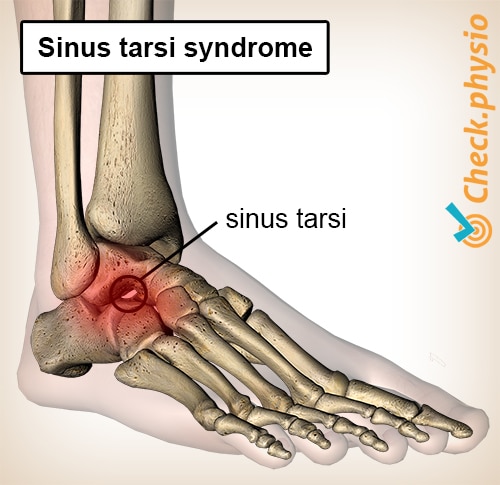Sinus tarsi syndrome
Lateral subtalar impingement syndrome
The sinus tarsi is a kind of tunnel that runs in the foot between the tarsal bones. This tunnel starts just before the lateral malleolus and then runs inwards at an angle. If the structures located here cause discomfort, this is referred to as sinus tarsi syndrome.

Description of the condition
The sinus tarsi tunnel contains ligaments, blood vessels and nerve branches. The outside of the sinus tarsi tunnel contains tendons and a joint capsuleas well. When these become excessively strained, complaints develop.
People with sinus tarsi syndrome suffer from pain on the outside of the ankle. It is experienced as a dull, stabbing or burning pain. It increases when the foot is strained even more or when making certain movements with the foot. The ankle may also become more stiff and unstable.
Cause and origin
Sinus tarsi syndrome can occur in various ways. For example, when there is an abnormality of the foot that causes it to tilt strongly inwards. This is the case with flat feet, and the structures in and around the sinus tarsi can become excessively strained as a result thereof. Because this happens with every step, chronic irritation or inflammation develops.
The disorder is most common in people who have (repeatedly) sprained the ankle. It is assumed that this happens in around 70% of all cases. It is often active sportsmen who get this disorder. But also people who are overweight and suffer from rheumatoid arthritis are at a higher risk.
Signs & symptoms
Symptoms that can occur with sinus tarsi syndrome include:
- Pain on the outside of the foot/ankle (dull, burning, tingling, stabbing).
- Aggravation of the symptoms when walking on uneven terrain.
- Difficulty walking on uneven terrain.
- Pain when moving the foot downwards or inwards.
- Reduction of the symptoms when wearing sturdy, high -cuffed shoes.
- Stiffness.
- Feeling of instability in the foot.
- Local swelling.
Diagnosis
If there are complaints in the area of the sinus tarsi, the doctor or physiotherapist will ask what the complaints are and how they developed. This is followed by a physical examination in which pressure on the sinus tarsi is painful. The position of the feet will also be examined. The focus will namely be on the inward tilting of the foot and the presence of a flatfoot.
When examining the mobility of the foot and ankle, moving the foot downwards and inwards is painful. This can also be the case when moving the foot upwards and outwards.
An X-ray can be taken to see whether there are any degenerative abnormalities. This is the case, for example, in arthrosis or rheumatoid arthritis. An MRI or CT-scan can clearly show exactly which structures in and around the sinus tarsi are affected.
Treatment
If the foot is misaligned, it can be supported by well-fitting shoes and orthotics. A podiatrist can help with this. In addition, it is important to train the stability of the ankle to prevent (repeated) spraining. Stiff joints also need to be mobilised again. If necessary, an injection of an anti-inflammatory and painkiller can help. In order to achieve an optimal result, it is often necessary to combine several of the above treatments.
All of this may not be enough and surgery is required. During surgery, the sinus tarsi is cleaned. After surgery, the patient has to walk on crutches with a special shoe for a fortnight. After that, the weight-bearing on the foot can gradually increase again. This can be done under the supervision of a physiotherapist.
Exercises
Follow the specially compiled exercise programme with exercises for Sinus tarsi syndrome here.
You can check your symptoms using the online physiotherapy check or make an appointment with a physiotherapy practice in your area.

References
Brukner, P. & Khan, K. (2016). Clinical sports medicine (Nederlandse bewerking). 4th edition. Michel van Troost. PreVision, Eindhoven.
Brukner, P. & Khan, K. (2010). Clinical sports medicine. McGraw-Hill: Australia. 3e druk.
Helgeson, K. (2009). Examination and Intervention for Sinus Tarsi Syndrome. North American Journal of Sports Physical Therapy. Volume 4, Number 1. Feb. 2009.
Wees, Ph.J. van der, Lenssen, A.F., Feijts, Y.A.E.J., Bloo, H., Moorsel, S.R. van, Ouderland, R., Opraus, K.W.F., Rondhuis, G., Simons, A., Swinkels, R.A.H.M., Vaes, P., Verhagen, E., Hendriks, H.J.M., Bie, R.A. de (2006). KNGF-richtlijn. Enkelletsel. Jaargang 116. Nummer 5. Update klinimetrie 2017.



